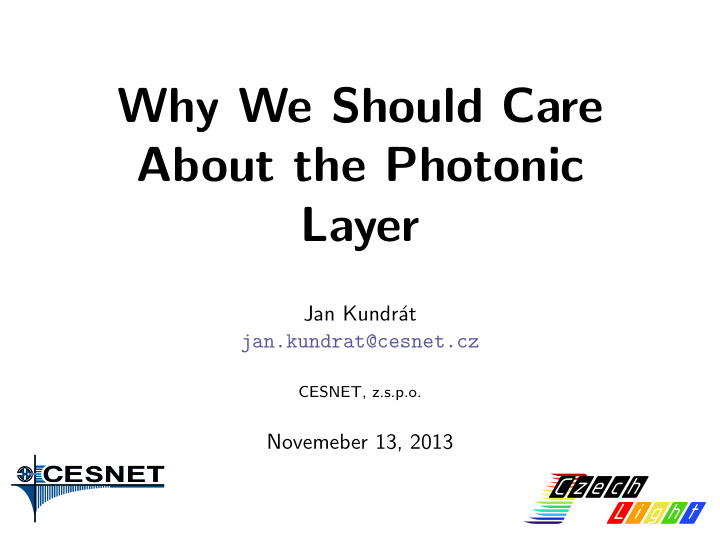



Why We Should Care About the Photonic Layer Jan Kundr´ at jan.kundrat@cesnet.cz CESNET, z.s.p.o. Novemeber 13, 2013
Fiber
Image courtesy of the US military
Attenuation Signal Level Distance
Chromatic Dispersion
Dispersion Compensation Image courtesy of www.fiberoptics4sale.com
100G Coherent Systems ◮ 100G Coherent Systems bring much better tolerance to the CD ◮ 29,000 – 80,000 ps compared to 1,200 ps for 10G ◮ DSP ◮ Vendors strongly recommend a DCM-free network ⇒ Problems when using 10G NRZ OOK and 100G simultaneously
100G Coherent Systems ◮ 100G Coherent Systems bring much better tolerance to the CD ◮ 29,000 – 80,000 ps compared to 1,200 ps for 10G ◮ DSP ◮ Vendors strongly recommend a DCM-free network ⇒ Problems when using 10G NRZ OOK and 100G simultaneously ◮ What about the upcoming 400G/1T links? ◮ We will need DC for long lines anyway
Compensating the Chromatic Dispersion ◮ Not only DCF, also Fiber Bragg Gratings (FBG) ◮ cheaper ◮ no non-linearities ◮ negligible delay (meters, not kilometers)
Compensating the Chromatic Dispersion ◮ Not only DCF, also Fiber Bragg Gratings (FBG) ◮ cheaper ◮ no non-linearities ◮ negligible delay (meters, not kilometers) ◮ Suitable CD compensation does not cause trouble ◮ Both 10G and 100G on the same link ◮ OK to run even < 1G PS with 100G at just 50 GHz separation
Having insight into the photonic layer saves people money.
But How Exactly? ◮ FBGs instead of DCFs ◮ Single-fiber transmission ◮ Up to 40% cost savings compared to a fiber pair ◮ Aggressive procurement policy with multiple suppliers
But How Exactly? ◮ FBGs instead of DCFs ◮ Single-fiber transmission ◮ Up to 40% cost savings compared to a fiber pair ◮ Aggressive procurement policy with multiple suppliers ◮ Advanced Services
What are these “advanced services” anyway? ◮ In general, making the network more versatile and “smarter” ◮ Some of them deployed for years already ◮ Frequency transfer ◮ Comparing atomic clocks of national time laboratories
What are these “advanced services” anyway?
What are these “advanced services” anyway?
What are these “advanced services” anyway? ◮ These are enabled by the nature of the Photonic Service ◮ No OEO conversion ◮ No DSP and the associated buffering
What are these “advanced services” anyway? ◮ These are enabled by the nature of the Photonic Service ◮ No OEO conversion ◮ No DSP and the associated buffering ◮ What does it bring?
The Photonic Service ◮ Low latency ◮ Negligible jitter ◮ Determinism!
Some potential has not been realized yet ◮ Remote control? ◮ Guaranteed transmission times ⇒ OK for hard realtime applications ◮ Telesurgeries?
Some potential has not been realized yet ◮ Remote control? ◮ Guaranteed transmission times ⇒ OK for hard realtime applications ◮ Telesurgeries? What else?
Services offered by CESNET ◮ A well-equipped laboratory ◮ See the backup slides for quick glance, talk to Jan Radil ◮ Partners for remote access much welcome! ◮ Expert personnel
Services offered by CESNET ◮ Experience with unusual setups ◮ Heterogeneous equipment ◮ Simultaneous 100G and slow-speed “analogue” photonic signal ◮ Time & frequency transfer, both across fiber pairs and single fiber & custom HW ◮ Automatic & distributed power balancing for power saving and lifetime improvements ◮ Hardware design – OpenDWDM CzechLight ◮ Licensed to several 3rd-party manufacturers for actual production ◮ Deployments outside and inside the CESNET network
How to provide these resources to the community? ◮ Trying to adapt the packet-based testbed stuff from GN3plus SA2 into the world of physical equipment ◮ Working on machine-readable testbed description ◮ Someone has to move the boxes and plug the patchcords, though
What is missing? ◮ Software tooling ◮ Vendor-neutrality is a must ◮ Full-stack integration with inventory management and NOC monitoring ◮ CESNET is interested in collaboration here
What is missing? ◮ Outreach – talking to the users! ◮ The network operators shall be involved in the network design ◮ Delegating the network design to a supplier is suboptimal on multiple fronts
Conclusion ◮ Having insight into the photonic layer is beneficial ◮ It isn’t hard, either ◮ And we can help you! ◮ Ask CESNET if you are interested
Acknowledgement Thanks to my colleagues at CESNET for their work ◮ Ondˇ rej Havliˇ s, Michal Haˇ zlinsk´ y, Miloslav H˚ ula, Jan Radil, Stanislav ˇ ıma, Pavel ˇ Skoda, Martin ˇ S´ Slap´ ak, Radek Velc, Josef Vojtˇ ech et al The work was partially supported by the Czech institutional funding of research by project Large Infrastructure CESNET LM2010005 and by the GN3 project (www.geant.net) under the EU FP7.
Thank you! Questions?
Backup Slides
CESNET’s Optical Laboratory ◮ Dark fibre facility with C and L band transmission ◮ Remote access – partners much welcome! ◮ Testers, analyzers and oscilloscopes and other expensive and not-so-common equipment ◮ Bit error rate testers (BERT): for 1/10/40G, 100G in near future ◮ Sampling oscilloscopes and constellation analysers for speeds up to 100G (and beyond) ◮ Testers for chromatic and polarization mode dispersion ◮ Fibre spools, G.652, G.655 (i.e. extension of field dark fibres) ◮ Different types CWDM/DWMD muxes, filters etc. ◮ Different amplification units (EDFA, PDFA, Raman, hybrid) for C and L bands ◮ ROADMs, including multidegree and flexigrid ◮ Different CD compensation units – Alien Waves etc.
Resources Cisco ONS 15454 Multiservice Transport ALU 1830PSS Photonic Service Switch Platform Optical Oclaro OTS- laboratories of EXFO PSO-200 Optical 4000 CESNET Modulation Analyzer StrataLight APEX-T AP2443B Optical Complex Spectrum Analyzer Optické komunikace 2012 3 Prague, October 25th, 2012 Slide from OPTOKOM 2012 in Prague
Recommend
More recommend